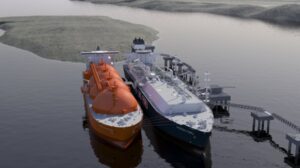– The LNG market is volatile, forcing flexibility on suppliers. They are supported by traders who take on the risk of market instability for a small fee. Will there be more LNG contracts with traders in Poland? – Wojciech Jakóbik, editor-in-chief of BiznesAlert.pl, wonders.
Intermediaries take risks
Due to the need for flexible market competition, the Americans from Cheniere Energy signed a fifteen-year contract for the sale of one million tonnes of LNG per year to the Swiss trader Trafigura. This is another example of trader’s involvement in trading, which production companies cannot manage.
Supplies to Trafigura will commence in 2019. In response to the development of LNG activities, shares of the Swiss company have increased in value. Last year it accounted for almost 8.5 per cent of the turnover in this market.
The company trades LNG in new markets, taking on the greatest risks. It is doing this, for example, in Egypt and Pakistan. It helps to use floating FSRU terminals, as in Klaipeda, Lithuania. Other traders do the same. Gunvor invested in LNG exports from Equatorial Guinea. Glencore buys LNG from Angola.
Due to bold export development plans, Cheniere Energy also needs the support of traders. It has an LNG terminal in Sabine Pass. It intends to launch Corpus Christi LNG. The implementation of this type of investment requires financial security, and this is possible thanks to new supply contracts.
The flexible one wins
However, achieving attractive conditions requires flexibility. LNG prices are volatile. Currently, they are again noting record levels in Asia and are the highest since January 2015. The average cost of LNG per spot in Japan amounted to USD 10.20 per mmBTU in December last year. That is 13.33 percent more than in November. The reason for this is the harsh winter in north-east Asia and the increase in demand in China due to the policy of carbon leakage.
The low temperatures were also responsible for the fact that the supply of LNG from Europe reached the American market. In January, a cargo was shipped to America from the UK’s Grain LNG terminal partially filled with gas from Russia supplied by the Yamal LNG project.
Another shipment from the Yamal gas port was delivered to France, where Elengy transshipped it from the Montoir-de-Bretagne LNG terminal from the oil tanker-icebreaker to a conventional one. The direction of this delivery has not yet been disclosed. Originally, Yamal LNG was supposed to re-export LNG via Europe to Asia during the winter season, but due to extreme frost in the USA, perhaps another cargo from Russia will be shipped to the local market. After the weather conditions change, the price in Asia may fall again and the attractiveness of the European market will increase. This volatility requires from suppliers the flexibility that the traders support, of course for a small fee.
Opportunity for Poland
It is not known how LNG competitiveness in Poland will be affected by price increases caused by severe winter weather. The increase in the price of crude oil, which costs nearly USD 70 per barrel on the stock exchange, will certainly be significant. At a time of price crisis, the value-dependent Yamal oil contract has increased its attractiveness compared to barrel-independent stock exchange prices. At present, as oil prices rise, the price determined according to the formula contained in the PGNiG-Gazprom agreement increases. This means that petroleum-independent contracts will again be more attractive, including those for LNG supplies, such as the PGNiG-Centrica contract indexed to the European exchange. Will the next ones follow?








